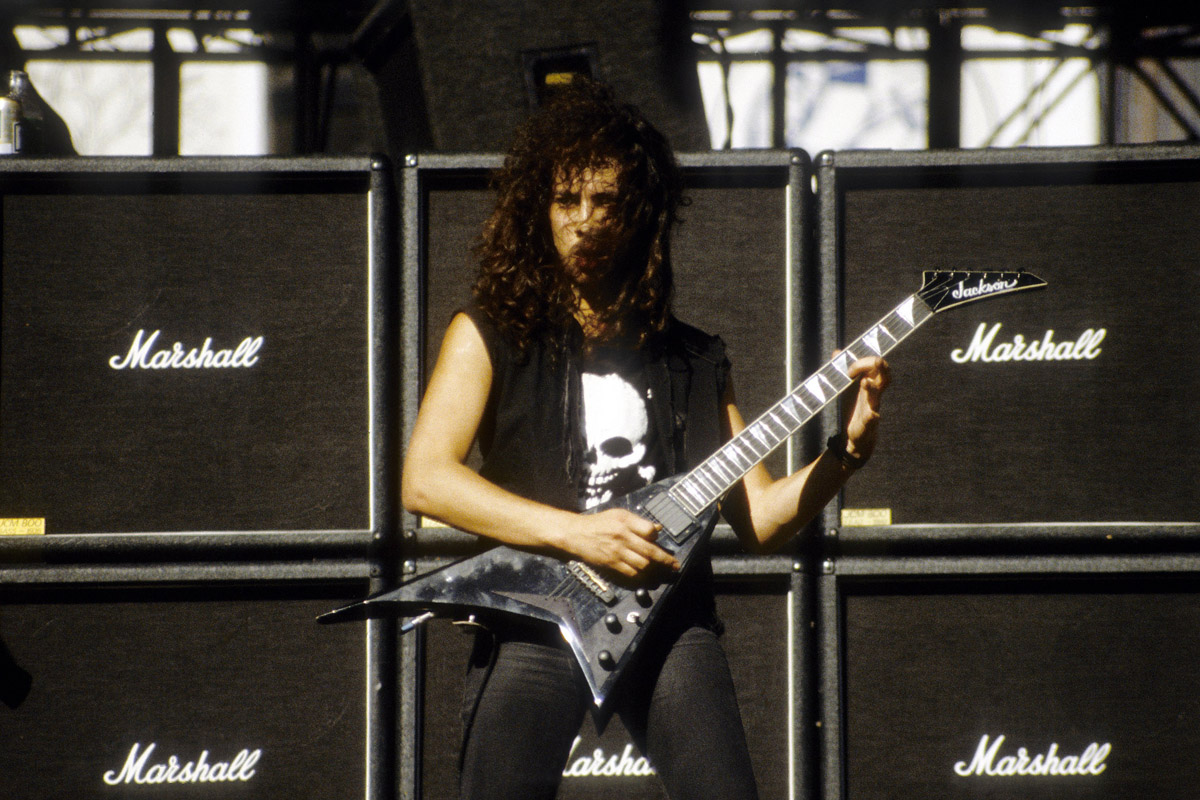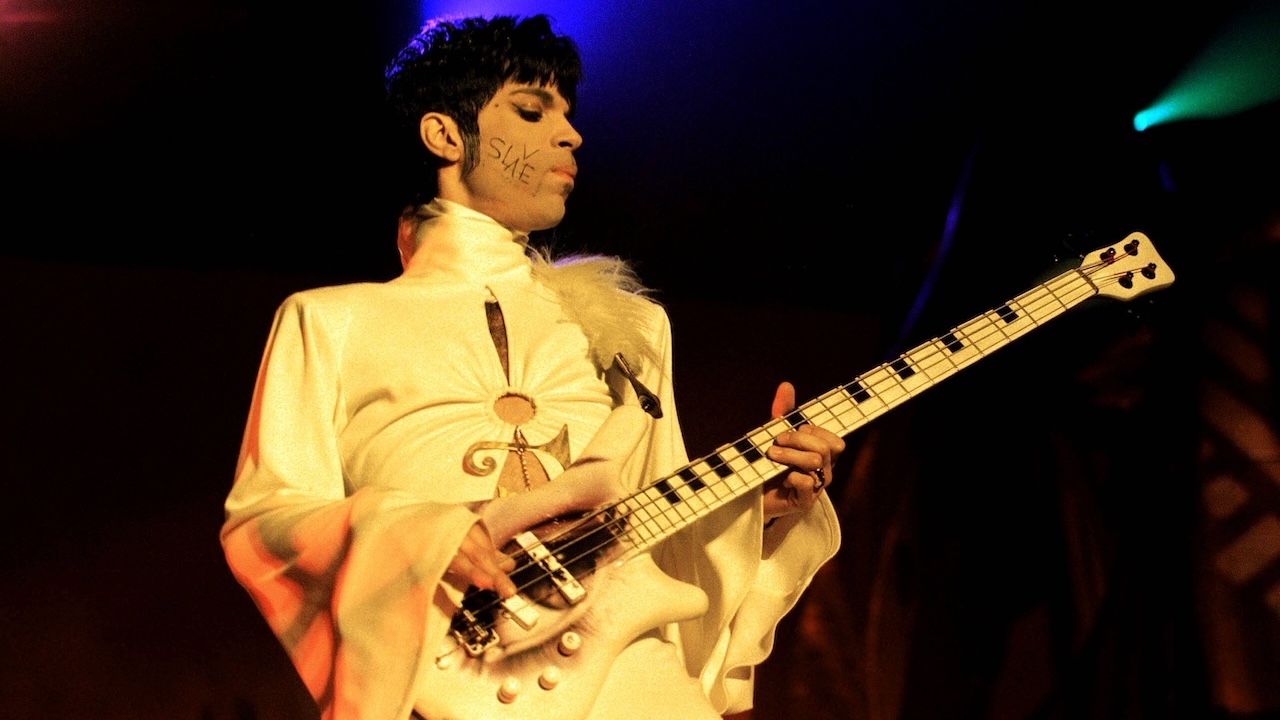The 50 greatest guitar solos of all time
The best lead playing ever committed to record, as voted by you
19. Reapers – Muse (Guitarist: Matt Bellamy, 2015)
If you’re planning on learning to play this single from Muse’s 2015 album Drones, you’re going to need to have your chops in order – it’s particularly well-endowed with shreddy moments throughout, from a Van Halen-inspired intro line to its Morello-esque Whammy-fuelled midway solo and a Radiohead-like ‘noise’ outro.
Based around 32nd notes (that’s eight notes for every beat), the intro is quite the speed challenge, and the placement of the tapped notes on the third of every group of four is tough to get a feel for.
As for the solo itself, you’ll need a DigiTech Whammy or similar treadle controlled pitch shifter to deliver those epic squeals. Matt’s note choice is far from straightforward. Only very briefly intuitive and bluesy, he spends most of his time here playing chromatic licks. Honestly, you just have to be Matt Bellamy to play this.
18. For The Love Of God – Steve Vai (1990)
The American virtuoso’s second album, Passion And Warfare, has become one of the most important instrumental guitar records of all-time – unparalleled in its search for new and inventive sounds to throw the listener’s ear and shatter expectations.
Its most popular track and a staple of Vai’s live appearances is a deep-dive into two E minor scales – Aeolian and Phrygian – starting out with a motif which he evolves and rephrases as things unfold, transitioning from smooth slides to furious bends.
And it only gets more frantic from there, using two-handed tapping, liquid legato and whammy bar techniques to twist what starts out as a deep soulful lullaby into a cacophonous nightmare. And yet there remains a real sense of purpose behind every single note, no matter how chromatic or overbent or over-the-top, making its six minutes the biggest musical statement of Vai’s career.
Any doubts over his music career without Whitesnake or David Lee Roth had been silenced – this was a maestro who could control the chaos, no matter where the music went. Truth be told, the power of instrumental rock guitar has never felt so magnetically potent.
Get The Pick Newsletter
All the latest guitar news, interviews, lessons, reviews, deals and more, direct to your inbox!
17. Still Got The Blues – Gary Moore (1990)
The notion of ‘making a guitar weep’ is one that has been around since the earliest blues recordings – but few rock players have ever been able to do it like Gary Moore, the undisputed master of the minor ballad. This wistful track in A minor became his calling card fairly late in his career, when he reinvented himself as a blues artist at the beginning of the 90s.
There’s a point in the solo where you can hear the Belfast great switch from the neck humbucker to the bridge on the 1959 Les Paul Standard he nicknamed ‘Stripe’ and start deviating from its main theme, mainly sticking within the A minor pentatonic scale, apart from a few occasional extra notes from the Aeolian and harmonic minor scales.
For the recording, Moore was plugged into his prototype Marshall JTM45 reissue head with one of the company’s newly designed The Guv’nor distortion pedals in front. It remains one of the most raw and expressive blues tracks of all-time, Moore living dangerously and almost fighting his guitar at points, and yet never failing to deliver the goods.
16. Back In Black – AC/DC (Guitarist: Angus Young, 1980)
The way Angus sets up and then winds up his own solo here is masterful, with the opening line reoccurring twice before climbing up to the fourth position of the E minor pentatonic scale on the seventh fret.
From there he heads to the first position an octave up at the 12th fret, which is where he remains for the rest of the solo until the closing line which is a higher reprise of that opening idea.
Then, of course, there’s that tone – his early 70s SG Standard going through a cranked Marshall, with some boost and compression coming from what’s often regarded as his secret weapon – a Schaffer-Vega Diversity System wireless transmitter and receiver.
15. Fade To Black – Metallica (Guitarist: Kirk Hammett, 1984)
Recorded at Flemming Rasmussen’s Sweet Silence Studios in Copenhagen (which the band would return to two years later for Master Of Puppets) in February and March 1984, Metallica’s sophomore album was more progressive and stylistically greater in scope than the all-out thrash assault of Kill ’Em All. Fade To Black features acoustic guitars, melodic solos and a non-standard structure more akin to the Stairway To Heaven school of songcraft.
Regarding the song’s epic outro solo, Kirk Hammett recently told TG: “I have been playing that song for so long now, what I do is for the very last solo – I know how I want to start it but then I am in an area where I can improvise for, I dunno, 16, 18, 24 bars, and then Lars will hit a certain fill which means that it’s up and it’s time for the arpeggio part. And then I just slide right into those arpeggios, and they are arpeggios played on two strings, not three.
“When guitar players first started incorporating arpeggios into their playing, before the whole Yngwie sweep-picking thing, arpeggios were played on two strings – not three or four strings – and so that was what the vogue was at the time in the 80s...
“Before the Yngwie sweep-picking thing, it was to play arpeggios that way and so I have been playing those for a long time and I use my middle finger just to anchor my position on the neck, at the 12th fret or 17th fret, 19th fret, whatever.”

Great tips from the man who plays the solos then, but how should you tackle the solo yourself?
First of all, there are two essential scales you’ll need to know: the B natural minor scale and the B Phrygian mode [shown here]. These cover you for the entire opening 30 bars, which, let’s face it, is a lot of music, so this is a damn good reason to learn a couple of shapes if ever we heard one!
To make it simpler, most of your time is spent in the natural minor scale. Not until around bar 20 will you find yourself briefly landing on the C note which appears in the Phrygian mode. The bottom line is: Kirk improvises this part of the solo live – and these are the shapes he uses. Up next are those two-string arpeggio shapes – 16th notes, all of them!
At 142 bpm that’s pretty fast, but Kirk doesn’t pick every note, opting to use pull-offs to make those rapid licks easier. It’s definitely something to experiment with and if you’re still struggling you could try adding in an occasional hammer-on, too.
14. While My Guitar Gently Weeps – The Beatles (Guitarist: Eric Clapton, 1968)
Perhaps one of the finest examples of Harrison’s songwriting during his time in The Beatles, While My Guitar Gently Weeps is also one of the Fab Four’s most iconic guitar tracks, thanks to a little help from Harrison’s friend Eric Clapton.
This pensive number was written during a period of disharmony in the group following their trip to India and subsequent study of Transcendental Meditation, and though neither solo is played by Harrison, the song was recorded in an era of the band that marked his return to the instrument following a period of sitar enthrallment.
The decidedly hard rock composition was more folky in its demo form, but its weighty subject matter – musing on the world’s lack of love – called for an appropriately forlorn style, which in turn acts as the perfect backing for Clapton’s soulful overdubbed lead guitar.
13. Highway Star – Deep Purple (Guitarist: Ritchie Blackmore, 1972)
Marking a breakthrough point for the British hard rock pioneers, 1972’s Machine Head launched Deep Purple into the stratosphere.
However, where side two opener Smoke On The Water set the band’s trajectory for rock immortality, it was this track where lead guitarist Ritchie Blackmore set out his stall. A forerunner of the neoclassical genre that would grow out of the 80s, Ritchie’s relentless alternate picking is on show in a 20-bar passage in this classic solo.
It’s a serious challenge to nail the part as Ritchie played it, but it’s possible to play it using hammer‑ons and pull-offs – albeit more loosely. Just make sure to give all four of your fretting fingers a warm-up. Every finger comes into play here in Ritchie’s impressive solo.
12. Purple Rain – Prince (1984)
It’s hard not to feel like Prince’s guitar work has often been overshadowed by his accomplishments as a musician in general, being a visionary multi-instrumentalist, songwriter and producer who left a mark on the world like no other. He was, in that regard, the full package, though that’s not to say his guitar playing wasn’t up there with the best of them.
The epic outro to Purple Rain – which takes up nearly two thirds of the song itself – stands out as some of his finest work on the six-string, wailing away in G minor pentatonic and very occasionally including some more modal notes like the minor 6th.
There’s also that repeating motif which dances around the 2nd and minor 3rd intervals – it’s simple and effective, setting things up for the vocal melody that comes in towards the end.
It’s not a busy solo by any means – instead, the Purple One chose to leave a lot of space in between the lines played and focus on big hooks instead of monster licks. There are many great live renditions of this track, but his half-time performance for 2007’s Super Bowl in Miami is the stuff of legend.
11. All Along The Watchtower – The Jimi Hendrix Experience (Guitarist: Jimi Hendrix, 1968)
This song tops any list of covers that are better than the original. Bands performing it live invariably refer to it as a Hendrix cover rather than Bob Dylan. Jimi’s rhythm playing is astounding, both in the intro and the deft chord/melody work of the verses, and of course, there’s the small matter of four solos to consider.
The man many refer to as the best of all time makes the most of his Strat and Marshall rig here – but it’s Jimi’s offering at the 2:20 mark that we’re interested in. Following an opening run of octaves, Jimi quickly gets into his stride with a typically blues-based minor pentatonic approach in C#.
At 2:32, the main solo explodes into a trademark combination of rhythm and lead, plus funky scratching on muted strings. It’s worth playing along with the scratches, trying to keep a loose wrist and consistent down-up strumming.
Those few beats alone will teach you a lot about Jimi’s groove and feel. To get the sound, select a bridge position single coil pickup, dial in delay at around 350ms, add compression for sustain and opt for a Vox wah pedal or something similar.
Current page: The 50 greatest solos of all time: 20-11
Prev Page The 50 greatest solos of all time: 30-21 Next Page The 50 greatest solos of all time: 10-1Total Guitar is one of Europe's biggest guitar magazines. With lessons to suit players of all levels, TG's world-class tuition is friendly, accessible and jargon-free, whether you want to brush up on your technique or improve your music theory knowledge. We also talk to the biggest names in the world of guitar – from interviews with all-time greats like Brian May and Eddie Van Halen to our behind the scenes Rig Tour features, we get you up close with the guitarists that matter to you.
“Tom would say, ‘Play your guitar with a car key.’ It was very experimental”: Little Feat's Fred Tackett recalls Tom Waits' left-field approach to guitar playing – and his one-of-a-kind studio sessions
“Seeing friends and heroes of mine having their solos plagiarized broke my heart”: Giacomo Turra used their solos note-for-note for his own viral content. Now the guitarists who had their playing “stolen” are speaking out











